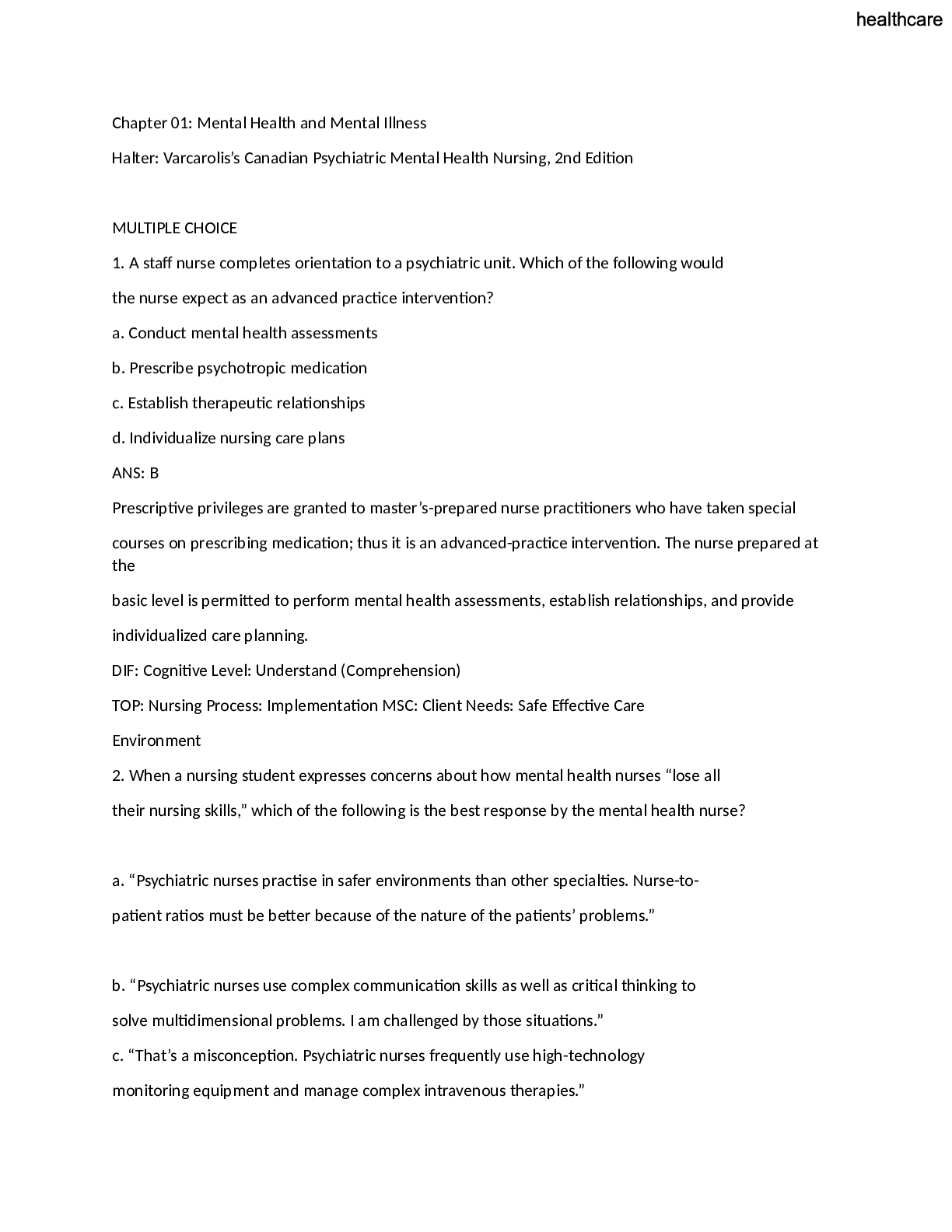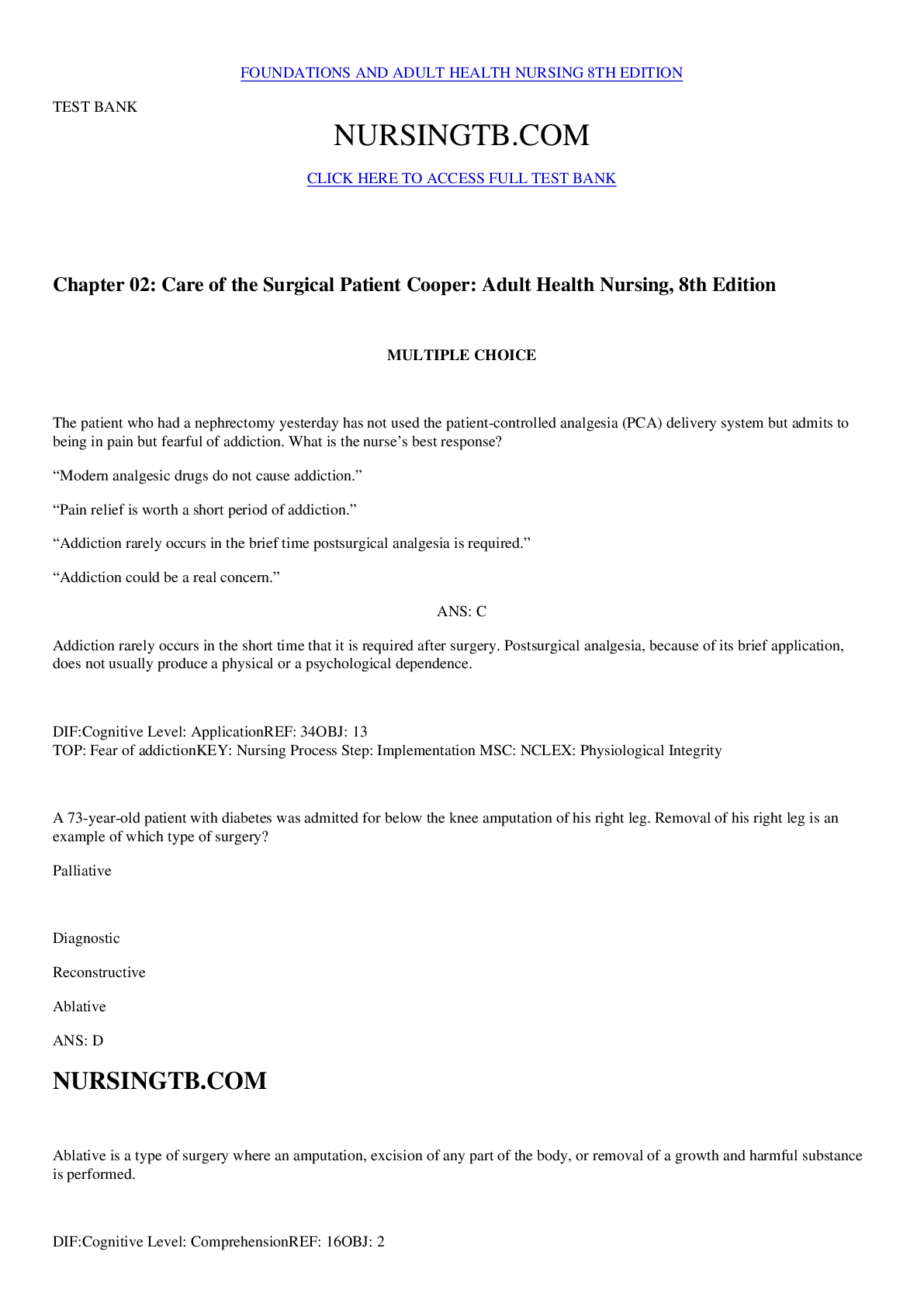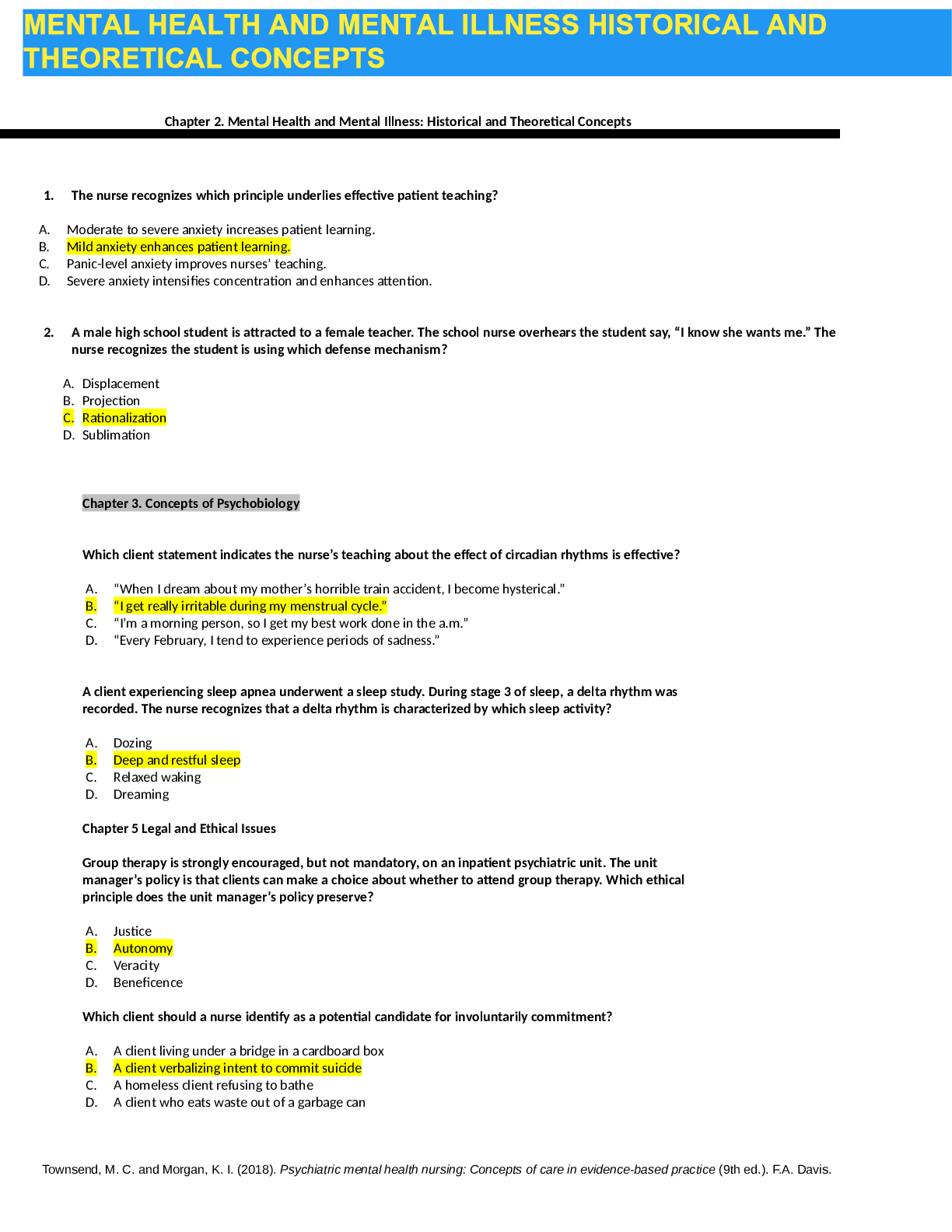*NURSING > QUESTIONS & ANSWERS > Chapter 1: Mental Health and Mental Illness. With Answers Explained (All)
Chapter 1: Mental Health and Mental Illness. With Answers Explained
Document Content and Description Below
Multiple Choice Identify the choice that best completes the statement or answers the question. ____ 1. A nurse is assessing a client who is experiencing occasional feelings of sadness because of t... he recent death of a beloved pet. The client’s appetite, sleep patterns, and daily routine have not changed. How should the nurse interpret the client’s behaviors? 1. The client’s behaviors demonstrate mental illness in the form of depression. 2. The client’s behaviors are extensive, which indicates the presence of mental illness. 3. The client’s behaviors are not congruent with cultural norms. 4. The client’s behaviors demonstrate no functional impairment, indicating no mental illness. ____ 2. At what point should the nurse determine that a client is at risk for developing a mental illness? 1. When thoughts, feelings, and behaviors are not reflective of the DSM-5 criteria. 2. When maladaptive responses to stress are coupled with interference in daily functioning. 3. When a client communicates significant distress. 4. When a client uses defense mechanisms as ego protection. ____ 3. A nurse is assessing a set of 15-year-old identical twins who respond very differently to stress. One twin becomes anxious and irritable, and the other withdraws and cries. How should the nurse explain these different stress responses to the parents? 1. Reactions to stress are relative rather than absolute; individual responses to stress vary. 2. It is abnormal for identical twins to react differently to similar stressors. 3. Identical twins should share the same temperament and respond similarly to stress. 4. Environmental influences to stress weigh more heavily than genetic influences. ____ 4. Which client should the nurse anticipate to be most receptive to psychiatric treatment? 1. A Jewish, female social worker. 2. A Baptist, homeless male. 3. A Catholic, black male. 4. A Protestant, Swedish business executive. ____ 5. A psychiatric nurse intern states, “This client’s use of defense mechanisms should be eliminated.” Which is a correct evaluation of this nurse’s statement? 1. Defense mechanisms can be appropriate responses to stress and need not be eliminated. 2. Defense mechanisms are a maladaptive attempt of the ego to manage anxiety and should always be eliminated. 3. Defense mechanisms, used by individuals with weak ego integrity, should be discouraged and not eliminated. 4. Defense mechanisms cause disintegration of the ego and should be fostered and encouraged. ____ 6. During an intake assessment, a nurse asks both physiological and psychosocial questions. The client angrily responds, “I’m here for my heart, not my head problems.” Which is the nurse’s best response? 1. “It is just a routine part of our assessment. All clients are asked these same questions.” 2. “Why are you concerned about these types of questions?” 3. “Psychological factors, like excessive stress, have been found to affect medical conditions.” 4. “We can skip these questions, if you like. It isn’t imperative that we complete this section.” ____ 7. An employee uses the defense mechanism of displacement when the boss openly disagrees with suggestions. What behavior would be expected from this employee? 1. The employee assertively confronts the boss. 2. The employee leaves the staff meeting to work out in the gym. 3. The employee criticizes a coworker. 4. The employee takes the boss out to lunch. ____ 8. A fourth-grade boy teases and makes jokes about a cute girl in his class. This behavior should be identified by a nurse as indicative of which defense mechanism? 1. Displacement 2. Projection 3. Reaction formation 4. Sublimation ____ 9. Which nursing statement about the concept of neurosis is most accurate? 1. An individual experiencing neurosis is unaware that he or she is experiencing distress. 2. An individual experiencing neurosis feels helpless to change his or her situation. 3. An individual experiencing neurosis is aware of the psychological causes of his or her behavior. 4. An individual experiencing neurosis has a loss of contact with reality. ____ 10. Which nursing statement regarding the concept of psychosis is most accurate? 1. Individuals experiencing psychoses are aware that their behaviors are maladaptive. 2. Individuals experiencing psychoses experience little distress. 3. Individuals experiencing psychoses are aware of experiencing psychological problems. 4. Individuals experiencing psychoses are based in reality. ____ 11. When under stress, a client routinely uses alcohol to excess. Finding her drunk, her husband yells at the client about her chronic alcohol abuse. Which action alerts the nurse to the client’s use of the defense mechanism of denial? 1. The client hides liquor bottles in a closet. 2. The client yells at her son for slouching in his chair. 3. The client burns dinner on purpose. 4. The client says to the spouse, “I don’t drink too much!” ____ 12. Devastated by a divorce from an abusive husband, a wife completes grief counseling. Which statement by the wife should indicate to a nurse that the client is in the acceptance stage of grief? 1. “If only we could have tried again, things might have worked out.” 2. “I am so mad that the children and I had to put up with him as long as we did.” 3. “Yes, it was a difficult relationship, but I think I have learned from the experience.” 4. “I still don’t have any appetite and continue to lose weight.” ____ 13. A nurse is performing a mental health assessment on an adult client. According to Maslow’s hierarchy of needs, which client action would demonstrate the highest achievement in terms of mental health? 1. Maintaining a long-term, faithful, intimate relationship 2. Achieving a sense of self-confidence 3. Possessing a feeling of self-fulfillment and realizing full potential 4. Developing a sense of purpose and the ability to direct activities ____ 14. According to Maslow’s hierarchy of needs, which situation on an inpatient psychiatric unit would require priority intervention by a nurse? 1. A client rudely complaining about limited visiting hours 2. A client exhibiting aggressive behavior toward another client 3. A client stating that no one cares 4. A client verbalizing feelings of failure ____ 15. How would a nurse best complete the new DSM-5 definition of a mental disorder? “A health condition characterized by significant dysfunction in an individual’s cognitions, or behaviors that reflect a disturbance in …” which of the following? 1. Psychosocial, biological, or developmental process underlying mental functioning 2. Psychological, cognitive, or developmental process underlying mental functioning 3. Psychological, biological, or developmental process underlying mental functioning 4. Psychological, biological, or psychosocial process underlying mental functioning Multiple Response Identify one or more choices that best complete the statement or answer the question. ____ 16. A nurse is assessing a client who appears to be experiencing some anxiety during questioning. Which symptoms might the client demonstrate that would indicate anxiety? (Select all that apply.) 1. Fidgeting 2. Laughing inappropriately 3. Palpitations 4. Nail biting 5. Limited attention span Completion Complete each statement. 17. _______________________ is a diffuse apprehension that is vague in nature and is associated with feelings of uncertainty and helplessness. 18. _______________________ is a subjective state of emotional, physical, and social responses to the loss of a valued entity. [Show More]
Last updated: 1 year ago
Preview 1 out of 12 pages
Instant download

Buy this document to get the full access instantly
Instant Download Access after purchase
Add to cartInstant download
Reviews( 0 )
Document information
Connected school, study & course
About the document
Uploaded On
Jan 27, 2020
Number of pages
12
Written in
Additional information
This document has been written for:
Uploaded
Jan 27, 2020
Downloads
0
Views
58


















 Correct Study Guide, Download to Score A.png)





